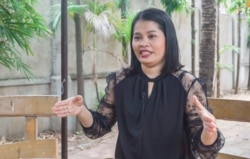PHNOM PENH -- When the coronavirus outbreak became a global pandemic in March, millions of people followed conferences and news broadcasts to understand this threat.
Sorn Sreynuch, 36 and a mother of two, also wanted to find out more. But while people around the world quickly got used to hearing and saying ‘coronavirus’ dozens of times a day, Sreynuch had to first figure out how to actually say the word: as a sign language interpreter, she had no dictionary to fall back on to.
She quickly went on YouTube to search for a new sign for COVID-19, the disease caused by the coronavirus. She was looking for something that would encapsulate the disease and the global threat it posed.
“Then, I asked deaf [colleagues], what sign should I gesture to make deaf people understand COVID-19,” Sreynuch said. “I explained to them that the disease is related to lungs and breathing, and I tell them how to protect themselves, washing hands and so on. They helped to create a new sign that is supposed to be understood by other deaf people [in Cambodia].”
In an interview with VOA Khmer, she explained the meaning of the symbol that they came up with. “This represents the earth, the world,” she said, clenching her left hand to perform the sign while moving her open right-hand palm around the fist, “and this shows it’s spreading all over the world.”
There are officially more than 520,000 people with disabilities in Cambodia, nearly 4 percent of the population. Of those, more than 40,000 are deaf, according to the latest official number, the Cambodia Socio-Economic Survey 2014. Others have estimated the number to be as high as 80,000.
Not Enough Translators
Prime Minister Hun Sen in 2012 called for Cambodian television stations to create programming to accommodate deaf people. And last year, he called on TV stations to include sign language on screen when broadcasting news programs, saying he would “monitor” them.
Yet, things are slow to change. There are only about half a dozen professional sign language translators to serve the 25 provinces and the capital Phnom Penh, according to Korn Maly, Sign Language Project Manager at the Deaf Development Programme. A number of other people were able to perform basic sign language and translate but did not pursue this as part of their professional career, she said.
In Cambodia, deaf people often face difficulties in accessing information, employment, or even seeking basic services. Being a professional sign language translator, Sreynuch said, she tried to empower deaf people by giving them important information to protect themselves and live a decent life.
In addition to interpreting news, she also translates short education video clips, she said. And in late April, the Ministry of Health requested her to translate at the weekly COVID-19 press conference.“It’s very demanding during this COVID-19 period,” Sreynuch said while getting ready to drive with her motorbike to a local TV station some twenty-four kilometers away. She had been requested to translate a broadcasting news program into sign language, she told VOA Khmer.
Sreynuch said deaf people faced some similar hurdles to illiterate people. “If they do not understand sign language, it can be hard for them to participate in society. If they learn sign language, it’s like those who can read and write: they can work and participate in society. So they are equal to others,” she said.
Sitting on a bench in a pavilion at her office among bamboo trees and enjoying a gentle breeze, she recounted how she came to be one of only a handful of professional interpreters in the country.
Sreynuch is not the only person in the family who knows sign language: Her mother cooked for deaf people, and this is how Sreynuch discovered her passion for sign language.
Now 60 and retired, her mother used to work for a local organization that supports people with disabilities in Phnom Penh. Back then, Sreynuch was 14 years old and began to make friends with deaf people who visited her home. She learned some basic signs from her mother.
“When we want to interact with them, we automatically try to learn their language,” Sreynuch said.
In 2002, Sreynuch attended a two-year sign language training program, including a course to become a professional translator. It’s the second batch of the program, which she said had only three students, including her sister and one other student. Briefly after, her sister married and moved to France with her husband. The other student, now working at Krousar Thmey of National Institution for Education, conducts research for Cambodian sign language.
The human resource in this sector is scarce, Sreynuch said. She explained that a range of factors were at play, such as a lack of interest and that the profession doesn’t bring in much income.
Sometimes, she said, she would interpret sign language for deaf people at hospital, at court, and during employment recruitment.
But it is personal moments that thrill her most. Sreynuch recalled her excitement when she provided sign language translation to a deaf couple's wedding early in her career. “I am happy because I could witness their moment of a happy marriage,” she said, adding that she for example explained what the “haircut ceremony” meant.
“Without the interpretation, they can only see what is happening but they don’t know what is going on. With my translation, when there are fun moments… they laugh too,” she said.
Employment Opportunities
Deaf people in Cambodia tend to work in the automobile repair and maintenance industry, makeup and hairdressing, in the garment industry, and in restaurants and cafés.
Socials Coffee and Humanity café in Phnom Penh aims to generate employment opportunities for the deaf and non-verbal community. Of a total of 12 staff members, it currently employs five deaf people.
Koy Socheata, a 25-year-old-barista at Socials Coffee and Humanity, is one of them. With the translation help of her colleague Seng Theary, she talked to VOA Khmer about how her life changed when she learned sign language.
“Before I knew sign language, I didn’t know others. I didn’t have the opportunity to be part of the people around me. I felt I was alone. But that changed when I started to learn sign language.” she said. “Never before did I know that there could be a place for deaf people to work.”
Socheata learned sign language at a school in Krousar Thmey when she was 14.
She finished high school in 2016 and began her studies at Asia-Europe University (AEU). But she had to drop out after the second year, because the courses were designed for non-deaf students and she could not catch up. The classes at universities in Cambodia do not have any sign language translators.
Socheata believes that special education through sign language is a much better option than trying to avoid vulnerabilities by keeping them at home, she said.
“A lot of parents love their deaf children, so they usually don’t allow the [deaf] children to go to school,” she said. “They keep the [deaf] kid at home so that they feel safer. If still unable to communicate once the kid goes to school, parents are often afraid [of danger].
But that was a fallacy, she said, explaining that it was empowering for deaf people to study and work. She urged parents to also send their deaf kids to school.
Her colleague Phem Vengheng, 22, started working at the cafe in 2018 after graduating from high school. Both he and his sister are deaf, among four siblings. Their parents sell pork at a market in Phnom Penh.
“My knowledge has broadened,” he said. “Before I learned sign language, I thought I am deaf - so I’d better stay at home to avoid facing problems. I didn’t know there were opportunities out there for me.”
Now Vengheng’s perception has changed.
“I want to be a teacher. I want to teach the deaf, because there are deaf who do not have the opportunity to go to school. Their parents don’t send them school. I want to transfer my knowledge to them,” he said.
Operation Manager Heng Sreynak, who is not deaf, told VOA Khmer that the cafe set up a 6-month sign language class when first opening the shop in 2018.
“At first it was very hard because I knew nothing about sign language,” she said. “I try to learn from them [deaf staff] and our teachers.”
Sreynak knows to value unique skills deaf people bring to the shop. “They have a good eye,” she said. “They quickly catch up with what we are doing.”
Stigma, Misconceptions and Risks
Before working at Socials Coffee, Sreynak said she barely knew anything about the deaf community.
“I used to wonder how the deaf communicated with each other. But after I get to know them here, I learned that they have their own language and they also attend schools,” she said. “Sign language helps connect us.”
This broadening connection between deaf and non-deaf, Sreynak said, also extended to customers. She said customers often tried to learn sign language from their staff. “They ask the speaking staff how they can gesture signs, and then they perform those signs and communicate directly with the deaf barista,” she said.
Like verbal languages, sign languages around the world differ depending on the country or region. Some countries discovered their sign languages more than a century ago, but in Cambodia it was only developed in the 1990s when different rights organizations began gathering deaf people and helped to structure the language.
Some countries have more than one sign language depending on the local region or even village.
But Korn Maly, the current DDP’s Sign Language Project Manager, said an international sign language made it possible for deaf people around the world to understand one another.
Maly said access to information was important to improve the livelihood of deaf people and reduce their risks. This, she said, was even more crucial during a pandemic.
Yeap Malyno, Director of the Welfare for Persons with Disabilities Department, said the Ministry of Social Affairs had set up a round-the-clock hotline specifically for people with disabilities through which they could contact an emergency response team.
“We know that people with disabilities struggle with access to information. Therefore, we use every means, including radio, poster, television and social media to send information about COVID-19.”
Malyno said that no person with a disability in Cambodia had contracted the disease so far.
But while sign language interpretation appears on television screens and on social media, not all deaf people are able to consume the knowledge or understand the message. Unless they learned sign languages, they cannot get full information from the translators either, Sign Language Project Manager Maly told VOA Khmer. She said no survey had been conducted to find out how many deaf people in Cambodia spoke Cambodian Sign Language, but estimated from her own observation that perhaps 70 percent of deaf Cambodians learned or understood the language.
The lack of sign language teachers and translators also makes access to knowledge and information for deaf people difficult.
“[When we] perform the signs, it does not mean [we can make] deaf people understand it. Sign language has to come with gestures, emotions, face expression, depending on the situation. The deaf have their grammar too,” Maly said.
Maly said many people carried misconceptions about deaf people. “Cambodians tend to think that the word ‘deaf’ means unable to ‘hear’ and ‘speak’ at the same time. In fact, deaf people have a voice,” she said, explaining that those born deaf could produce sounds and had the physical ability to speak, but as they could not hear, they could simply not imitate sounds.
Aside from facing difficulties in accessing information, education, and communication, deaf people - especially women - are vulnerable to abuse. People were taking advantage of a perceived helplessness of deaf people.
“Deaf women are more likely to become subject to sexual abuse when they go to quiet places like a rice field. Because they [the abusers] think that deaf women cannot report the case,” she said. “Sometimes, they get pregnant and we do not know who did it. They have gone through so much pain.”
Having grown up seeing her mother juggle a job and caring for three children as a single mum, Sreynuch wanted a job that would prosper her family’s income. As a sign language interpreter is not one of those jobs, after graduating from high school and working as a translator for a year, Sreynuch took a degree in Accounting and Finance at the National University of Management in the hope to find a job in the financial sector.
But things worked out differently.
“I thought I wanted to [be a translator] for a year, after that I will find a new job. But, after I keep working, it turns out I like it more and more. […] I love it so much that I cannot stop doing it.” Sreynuch said. “It’s a job that makes me happy… It’s a job that helps deaf people.”
Sreynuch raises two children. As the oldest, a six-year-old boy, doesn’t have class since schools were closed to prevent the spread of COVID-19, she keeps him busy with her own curriculum.
She teaches him Cambodian Sign Language.







